This easy and delicious Salmon Stir Fry is a healthy, low-carb healthy weeknight meal that you can make using one pan in just 30 minutes! Enjoy tender pieces of salmon and fresh, crisp veggies doused in a homemade teriyaki sauce served over rice or noodles. It is so easy yet flavorful, you’ll find yourself making it again and again!
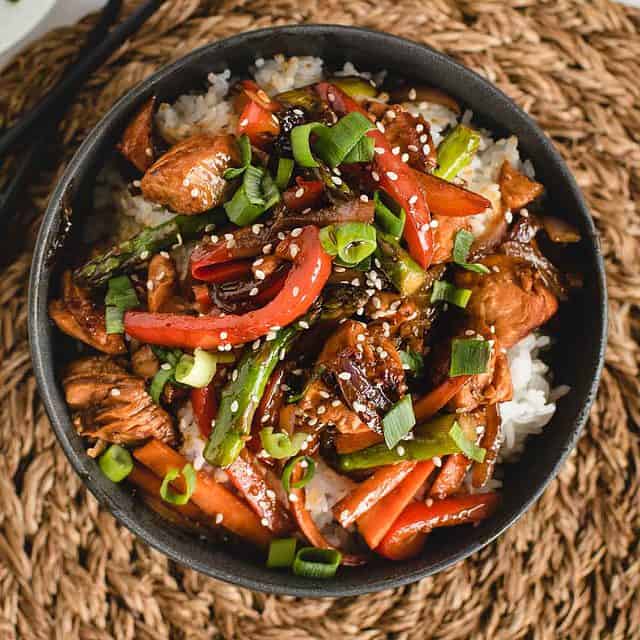
When I need a quick and easy yet satisfying meal, one of my go-to proteins is salmon. It cooks to flaky, buttery perfection without the need for prolonged preparation or cooking.
Case in point are my Traeger Smoked Salmon and Baked Lemon Dill Salmon recipes! They are some of the best and easiest ways to enjoy this omega rich protein-packed fish.
Reasons to Love this Dish!
This teriyaki salmon stir-fry is another easy salmon recipe that you must try. An Asian-style dish that you can make in a jiffy yet tastes as good as any you’ve had in any restaurant- or even better!
It is also quite nutritious. You will get your daily dose of vitamins and fiber from bell peppers, carrots, asparagus, and onion plus protein and omega-3 fatty acids from the salmon. Serve it with white rice, brown rice, quinoa, Korean fried rice, Thai fried brown rice, soba noodles or cauliflower rice for a low-carb option.
Another plus is that it is easy to customize using other vegetables that you have or like. No need for a wok or anything special either since a regular large frying pan works fine. It’s the perfect addition to your weekly meal rotation!
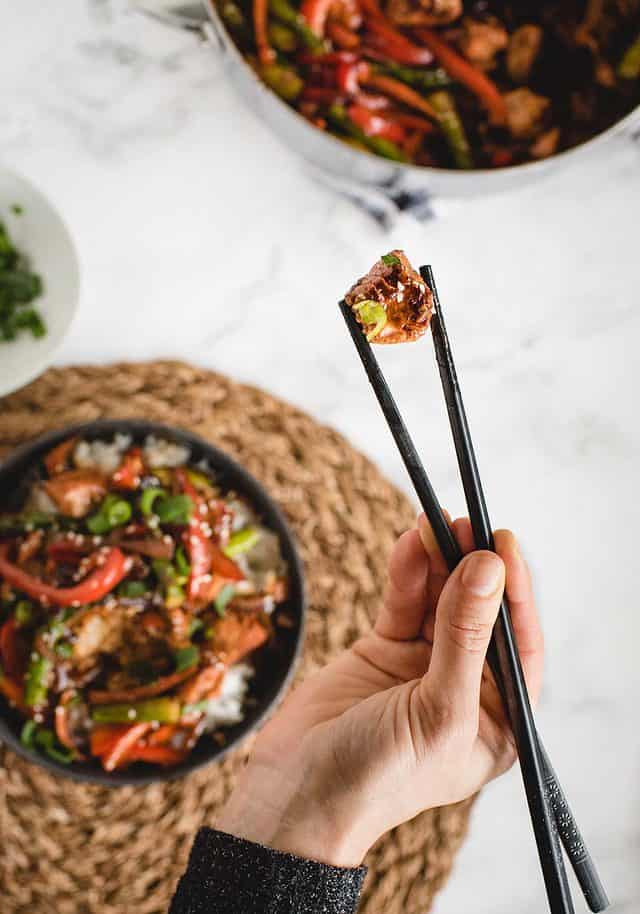
Ingredients You’ll Need
This healthy salmon stir fry is made of easy-to-find simple ingredients and a handful of pantry staples! Here’s the list of what you will need and possible alternatives too.
For the stir fry
- Salmon– use a good quality fresh salmon filet that is about an inch thick. Wild caught salmon is always healthier than farm raised but get the best your budget allows. Since it has a flavorful marinade, it is more forgiving than other recipes but freshness is always important when cooking fish.
- Vegetables- you will need red bell pepper, carrots, asparagus spears, and red onion. You can also use other fresh vegetables like green beans, zucchini, edamame, broccoli, baby corn, snow peas, sugar snap peas, water chestnuts and mushrooms. You could even add delicate vegetables like bok choy or kale at the very end if you want to. Just make sure to use the amount of veggies indicated in the recipe or you won’t have enough sauce.
- Avocado oil -or other high-heat flavorless cooking oil like sesame oil. Do not use olive oil here, it will smoke too much since we’re cooking at a high temperature.
For the stir-fry sauce
- Low-sodium soy sauce– this is the base of the sauce that gives it a savory, umami flavor. Make sure to use low-sodium over regular soy sauce. You can also use tamari sauce to make it gluten-free. Coconut aminos can make it paleo but will alter the flavor making it sweeter so you may need to add additional salt at the end if using this.
- Water– you will need a cup of cold water or substitute it with low-sodium vegetable or chicken broth for even more flavor.
- Rice vinegar– to add a bright tangy taste! Apple cider vinegar or other neutral vinegar types will work here but you may need to add a pinch more honey too taste since rice vinegar is sweeter and more mild.
- Honey– it’s sweetness will balance the flavors of the sauce nicely. You can also use coconut or brown sugar in it’s place.
- Arrowroot– this will give the sauce a thicker and silky texture. A good alternative for this is cornstarch. You will need to use less (just 2 teaspoons) if substituting cornstarch though so make sure to read the note on this in the recipe.
- Aromatics- I used both garlic cloves and ginger for a sharp punch of flavor.
- Chili garlic sauce– a dash of spiciness is always a great way to make any dish more appetizing! You can add more or less depending on your preference. Sriracha is a good substitute.
- Sesame oil– this helps create a smoother texture and adds flavor.
Garnishes (optional)
- Sesame seeds – mostly for visual appeal since they don’t add much flavor
- Sliced green onions – or you can use spring onion if you prefer
- Whatever else you want! Cilantro is delicious here or a squirt of lime juice or red pepper flakes for more heat. Feel free to experiment and play around with what you have and/ or tweak the garnishes to your preferences.
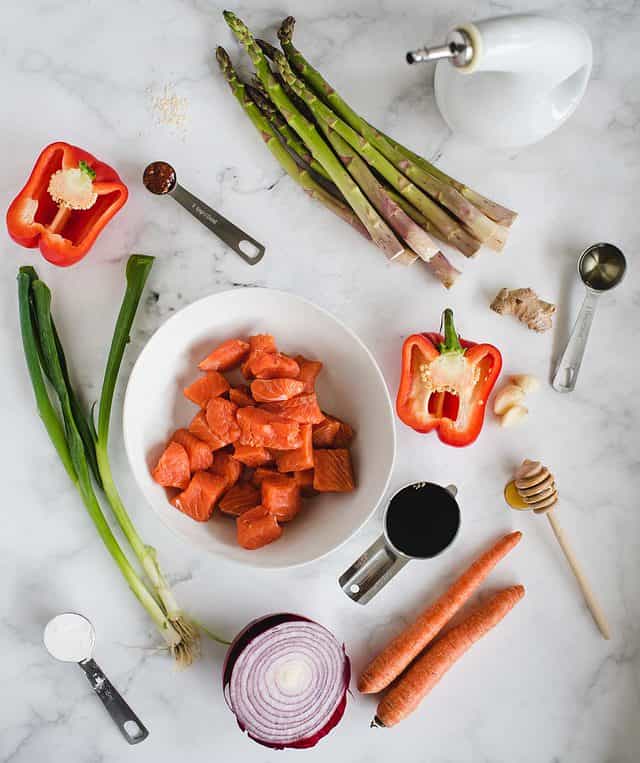
How to Make Salmon Stir Fry
Stir fries are one of the quickest ways to cook food! All you need is a pan or skillet and a few minutes to get this delicious dish on your table. Let’s get started.
Steps:
- Make the teriyaki sauce. Add the soy sauce, rice wine vinegar, honey, water, chili, sesame oil, garlic, and ginger together in a medium-sized bowl. Add the arrowroot and continue to mix until the honey and arrowroot are fully dissolved.
- Prepare the salmon filet. Remove bones using tweezers and skin using a sharp knife. Cut into 1″ cubes.
- Marinate the salmon cubes. Add the salmon pieces to the bowl and toss to coat. Set aside to marinade for about 15 minutes while you prepare the vegetables.
- Chop the veggies. Make them about the size pictured below and described in the recipe.
- Sauté the veggies. Heat oil in a large skillet over medium-high heat. Once hot, add the bell pepper, carrot, asparagus, and onion and sauté. Move the vegetables to a plate and set aside for later.
- Cook the marinated salmon. Add more oil to the same pan and sear the salmon in it. Save the marinade for later! Since the salmon only sat in the marinade for a brief time, it’s still safe to use.
- Sear the other side. Flip each salmon piece over and sear the other side until mostly cooked through.
- Add the remaining stir fry sauce and veggies. Pour the leftover sauce and vegetables into the pan. Gently toss and let cook another minute or two until the sauce has thickened.
- Garnish and serve! Remove the pan from heat and top with green onion and sesame seeds or whatever you prefer to use. Serve the stir fry salmon over rice, brown rice, quinoa, cauliflower rice, udon noodles, eat plain or however you want it.
Helpful Tips for You
- To make your meal preparation faster, you can make the marinade ahead of time and cut/slice the veggies and salmon too. Place them covered in the fridge to keep them fresh. Remember to marinate salmon for at least 15 minutes before you are ready to make the recipe but wait to do this until you’re ready to cook it.
- Be mindful when marinating the salmon cubes. Do not marinade longer than recommended because the salmon flesh will start to break down and get a spongey texture.
- When stir-frying, you should have all your ingredients ready and within reach before you start because you will have to work fast.
- Make sure your pan is medium-high heat for best results. If your pan isn’t hot enough the veggies and salmon will steam instead of sear making the dish less flavorful. If cooked over high heat, it will scorch and blacken so make sure you get it right with the vegetables before adding the salmon cubes.
- Be gentle when flipping the fish to keep each piece intact. If the cubes are still sticking to the skillet, leave them on for a few seconds to cook more. They should be easy to flip once the surface is golden and crisp.
- Do not overcook the salmon or they will turn out dry and tough to chew instead of tender and flaky.
- If you are planning to serve this with steamed rice, start cooking it while the salmon is marinating.
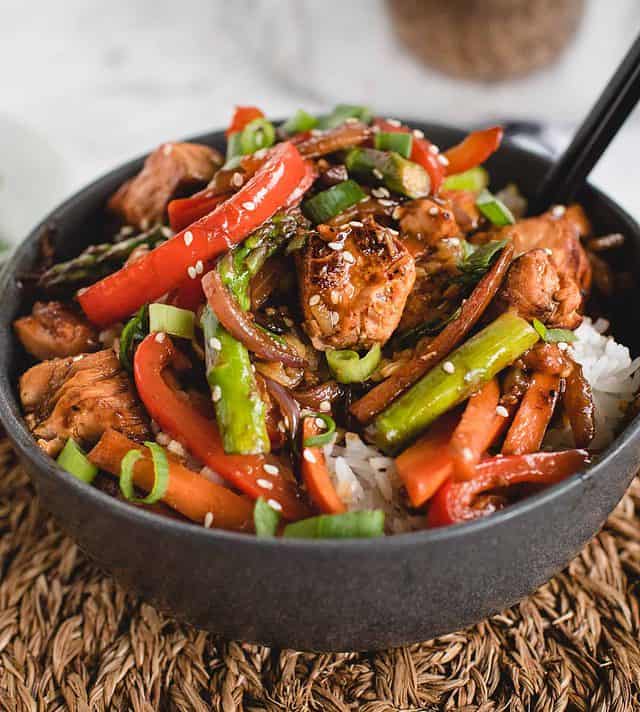
Frequently Asked Questions
This is a traditional Japanese sauce usually made of soy sauce, mirin or sake, and sugar to give dishes a salty-sweet flavor through sauce. You can buy them ready-made in grocery stores but I prefer making my own to control the ingredients to my liking.
To make stir fry gluten-free use tamari instead of soy sauce. Coconut aminos is also gluten free and will make the recipe paleo.
Salmon cooks fast. The salmon pieces should be uniform color on the inside and still moist when you cut into it. If it feels tough and flakes too easily, it is overcooked. If you’re unsure, remove the pan from the heat and cut into the largest salmon cube to check for doneness.
Storing
Leftovers can be kept in the refrigerator for 2-3 days in an airtight container. You can reheat it using the microwave or a stove top over low heat. Please note that if the salmon is not fresh, it won’t last as long in the refrigerator. As with most fish, this dish is best eaten fresh, the day it is cooked.
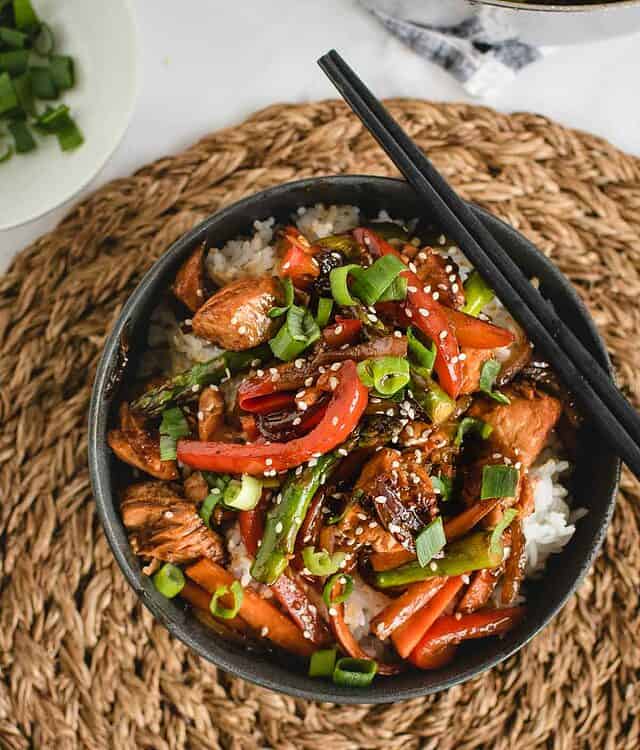
Equipment
- 1 medium bowl to marinate salmon
- 1 Large wok or rimmed skillet
- 1 Thin flat spatula for stirring and flipping
Ingredients
- 1 lb. salmon
- 1 red pepper
- ½ ed onion
- 2 carrots
- 8-10 asparagus spears
- 2 Tablespoon avocado oil or other high heat flavorless cooking oil, divided
Teriyaki sauce
- 1/3 cup low sodium soy sauce or tamari or coconut aminos*
- 1/3 cup cold water or low sodium vegetable or chicken broth
- 1 Tablespoon rice vinegar
- 2 Tablespoons honey or substitute coconut sugar, or brown sugar
- 1 Tablespoon arrowroot see notes for substituting cornstarch
- 2 teaspoons minced garlic
- 1 teaspoon minced or grated ginger
- 1 teaspoon chili garlic sauce or sriracha; add more or less based on your spice preference
- 1 teaspoon sesame oil
Garnishes (optional)
- Sesame seeds
- Sliced green onion
Instructions
- Add teriyaki sauce ingredients to a medium sized bowl and whisk to mix in until honey and arrowroot are dissolved.
- Run your fingers across the salmon to see if there are any bones and remove using tweezers if you find any. If your salmon has skin on, remove it using a sharp knife and discard it. Cut salmon into 1” squares.
- Add salmon cubes to teriyaki sauce marinade and toss to coat. Set aside while you prepare the veggies (salmon should marinate for about 15 minutes but not more than 30).
- Slice the red pepper and onion into thin wedges, discarding the outer layer of the onion and seeds and stem of the bell pepper. Separate the layers of the onion. Peel the carrots and cut into matchstick sized pieces. Cut woody bottom ends off asparagus and discard, cutting the remaining stalks into 1-2" pieces.
- Heat 1 Tbsp oil in a large skillet over medium-high heat. Once hot, add the bell pepper, carrot, asparagus and onion and sauté for 4-5 minutes until seared but still crisp. Remove vegetables to a plate and set aside.
- Add another tablespoon of oil to the same pan and tilt the pan to spread the oil evenly across the pan. Add the salmon cubes in one at a time without using a slotted spoon, fork or tongs, saving the marinade for later.
- Allow the salmon cubes to sear for 2 minutes. Do not stir the salmon! Use a thin spatula to quickly individually flip each salmon cube over and sear the other side for an additional 1-2 minutes until until outside is seared and inside is almost fully cooked. Be careful not overcook since the salmon will continue to finish with the rest of the ingredients.
- Pour the teriyaki sauced used for the salmon into the pan and let come to a simmer for 1 minute (necessary for food safety), then add vegetables and gently toss to coat everything in sauce. Let cook for another 1-2 minutes until sauce has thickened, stirring very gently to keep salmon from breaking up.
- Remove the pan from heat and top with desired garnishes (I like sesame seeds and green onion) or plate and then garnish. Serve immediately over rice, brown rice, quinoa, cauliflower rice or whatever you prefer.
Notes
Nutrition
did you make this recipe?
Make sure to follow on Pinterest @feastingnotfasting and on Instagram @feastingnotfasting
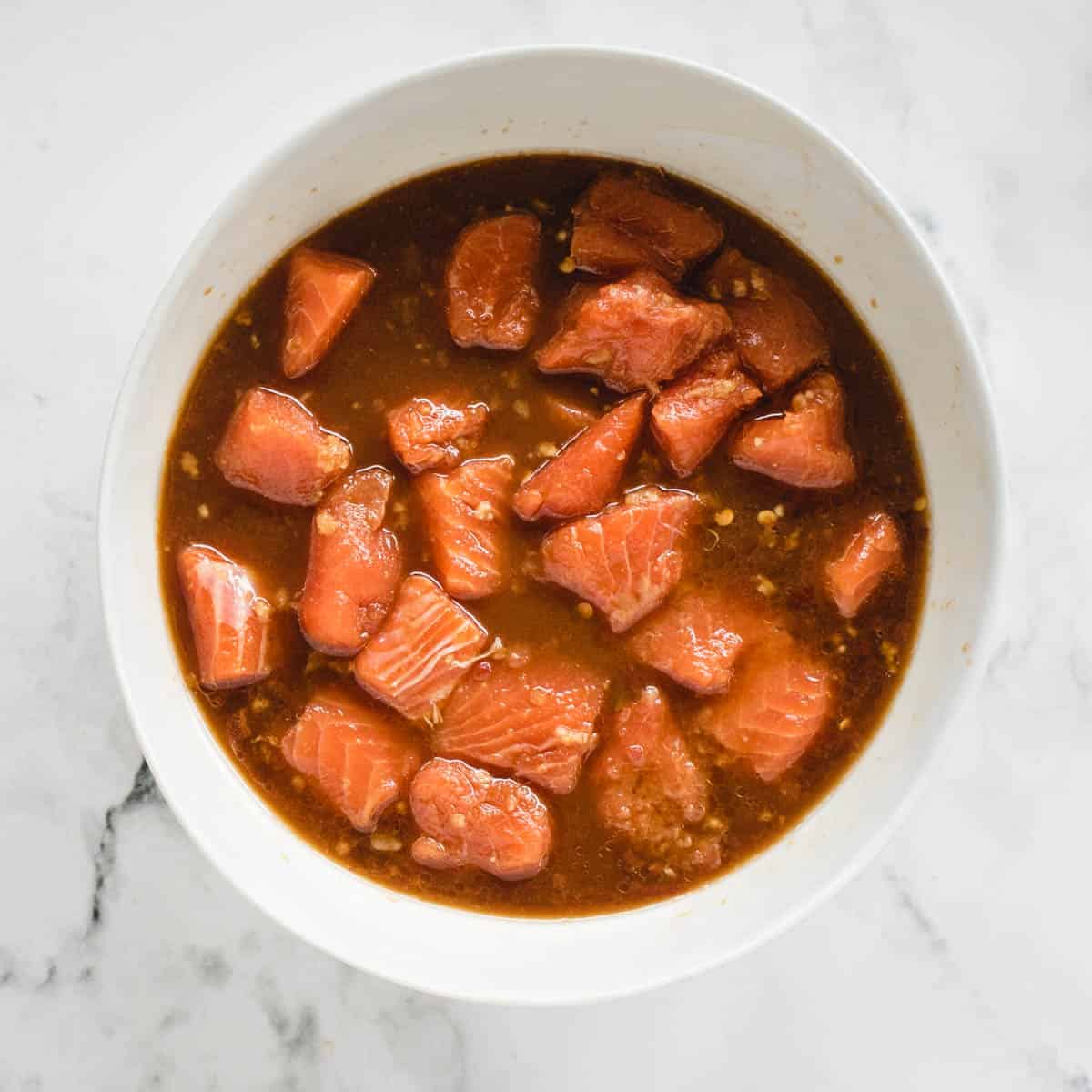
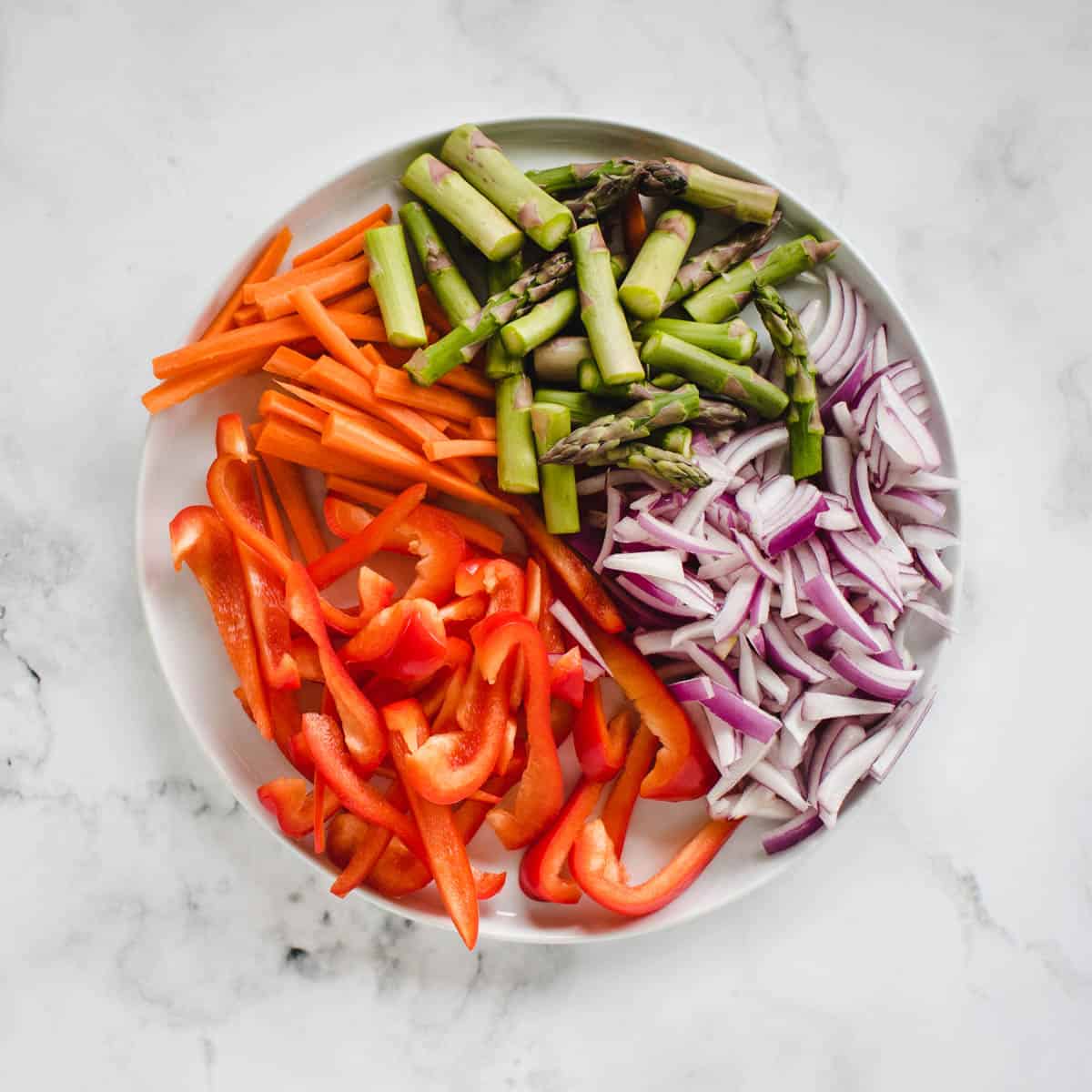
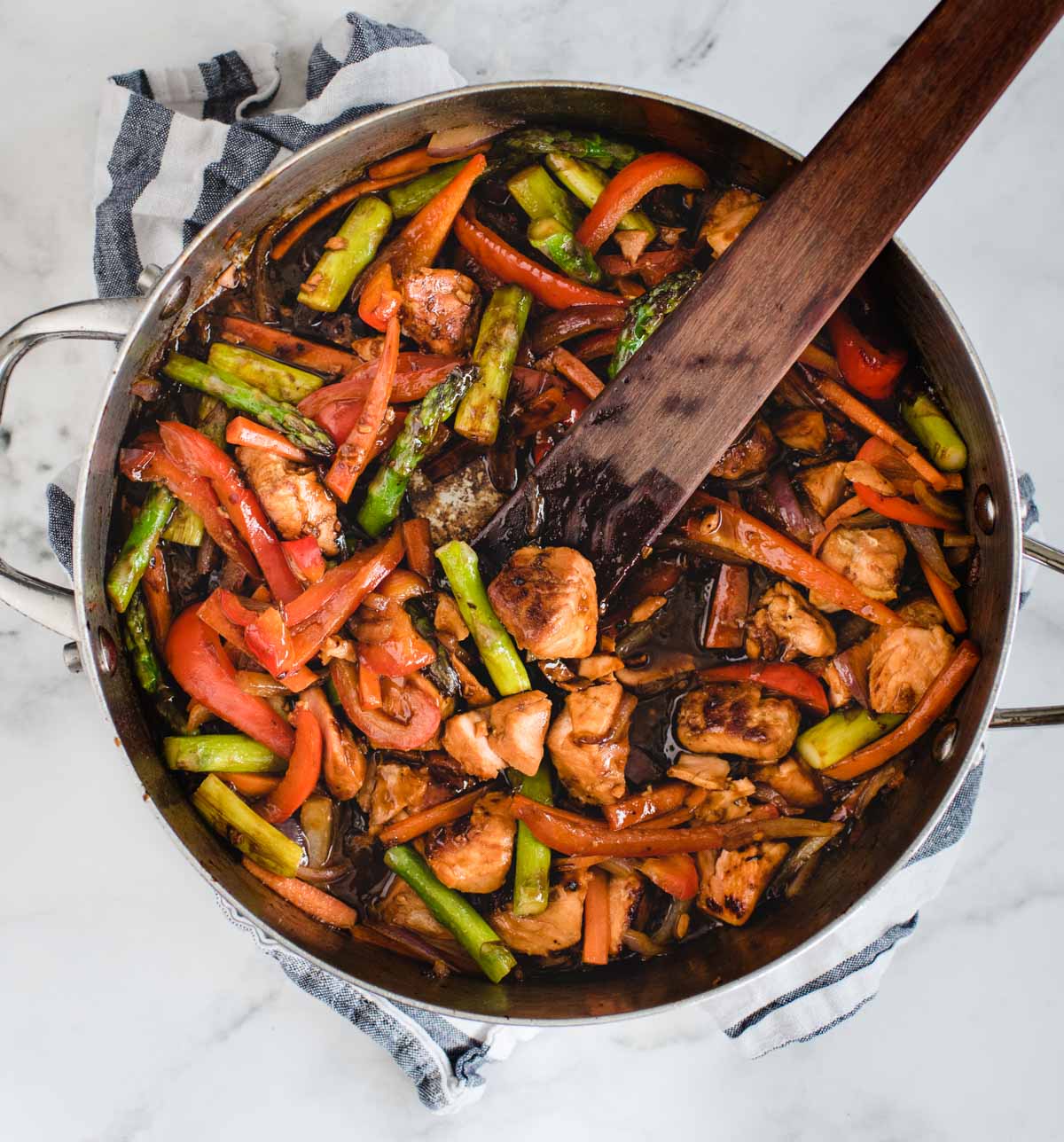
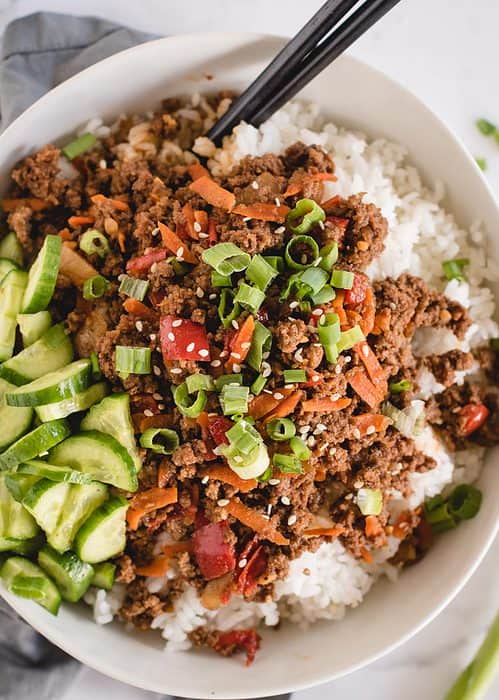
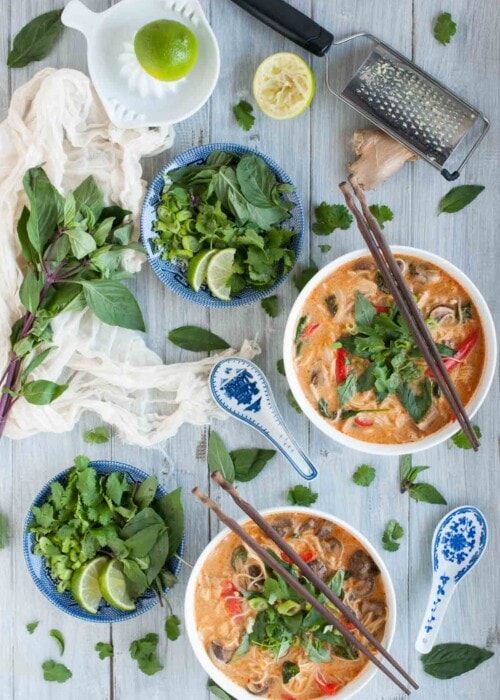
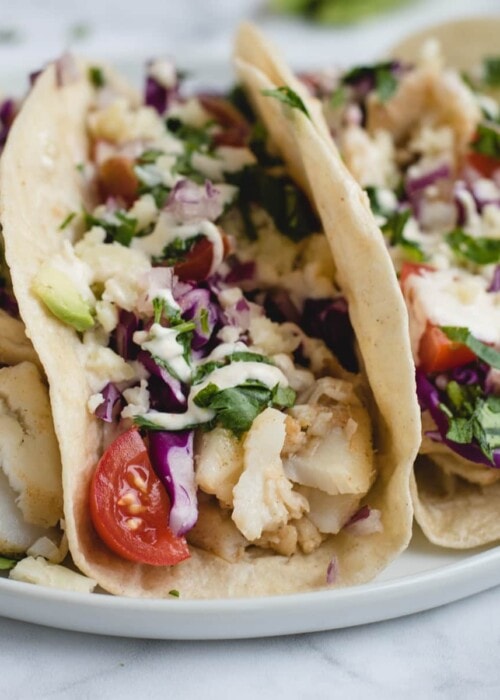
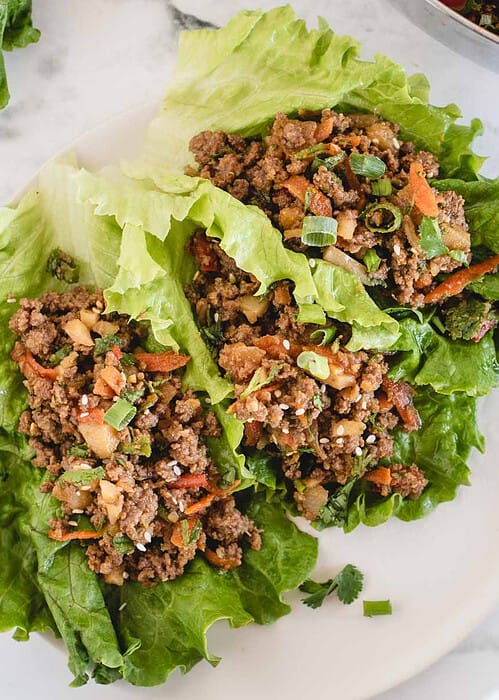
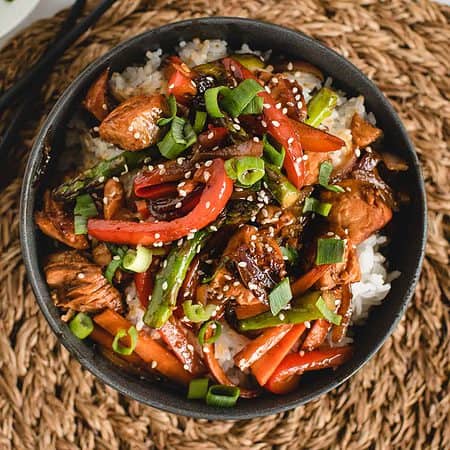








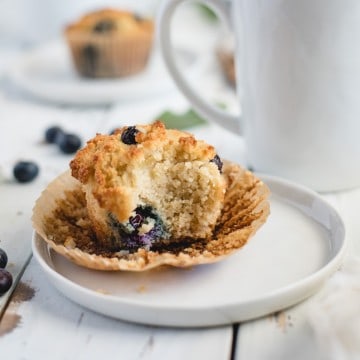

Comments & Reviews
This is so good! I was worried there wouldn’t be enough sauce but it turned out perfect!
Thank you for letting me know it turned out well for you!
I just made this for dinner last night and we loved it! Ha, I’m tempted to eat the leftovers for breakfast. Best stir fry ever!
I feel the same way! I’ve been known to eat last night’s dinner for breakfast on multiple occasions! I’m so happy you liked the recipe that much!